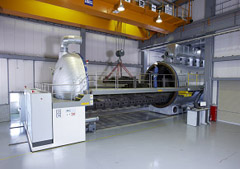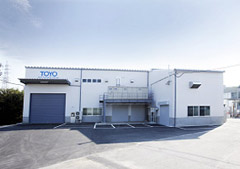新闻发布
2008/11/11
日本首台PPD处理炉在东洋先进机床名古屋工场正式开始运转
- 实现大型冲压模具寿命的飞跃性提高的日本第一大超大型氮化炉 -
Toyo Advanced Technologies Co., Ltd. (head office: Minami-ku, Hiroshima, Japan; President: Yasuto Tatsuta) held an initial igniting ceremony today for its new PPD (pulse plasma diffusion) treatment furnace, celebrating the completion of the facilities solely for PPD treatment,PPD treatment is a hardening treatment technology for dramatically making the life of dies longer. Toyo believes that there is a good demand for this treatment, and began construction of PPD treatment furnace at Nagoya Plant last spring. Today's ceremony celebrated the start of operation of this PPD treatment furnace—Japan's first—and was attended by Toyo directors, including Vice President Nariaki Uchida, and employees working there.
PPD treatment is a unique technology, developed by German company Oerlikon Balzers VST, that penetrates and diffuses nitrogen, carbon and oxygen in the metal surface of dies and other parts by generating a plasma through pulse discharge in a vacuum. The PPD treatment furnace introduced by Toyo is an ultra-large one, its internal diameter : Φ3.7m, inner length : 10m and one of the largest nitriding furnaces in Japan. One of its major features is its capacity to treat large press dies, such as dies for automobile outer panels, on which hardening treatment was not previously applied.
Equipment enabling nitriding or hard coating was unavailable in the past for large pressing parts such as the outer panels of automobiles because the dies themselves are too large. Therefore, the conventional approach for extending die life was to plate the die with hard chrome or a similar material. However, plating treatment means applying a metal coating on the surface of the die, and thus there are several problems: (1) Plating tends to peel off or otherwise be damaged at points where pressure is high, and those points must be replated; (2) The gap between concave and convex parts of the die varies due to the coating thickness, and it takes much time to adjust the die after treatment; and (3) Since welding on plated parts is not possible, plating must be stripped to make die repairs such as overlay welding.
In PPD treatment, the die itself is hardened at a low temperature of approx. 500 to 550°C (temperature below the transformation point of the base material), so the treatment does not only extend die life dramatically, but also has the advantage of maintaining dimensional accuracy. Furthermore, dies are easily repairable, and unlike plating treatment, PPD produces no waste fluid, both of which contribute to global environmental protection. PPD treatment is far superior to chrome plating treatment in terms of performance, and PPD facilities are already running at European and US plants of Oerlikon Balzers VST. Due to growing concern for environmental issues, automakers in Europe and the United States are increasingly using PPD, and in four years it has been applied to more than 3,500 dies. Toyo is the first to introduce the technology in Japan, and will now be making full-scale sales efforts targeting primarily at domestic automakers and die manufacturers.
-

-

PPD treatment facility (at Nagoya Plant)
■PPD treatment furnace specifications
Furnace internal dimensions (inner diameter x length): Φ3.7 m x 10 m
Installation dimensions (width x depth x height): 25 m x 8 m x 6 m
Max. work weight: 40 tons
■Main features of PPD treatment
Superior treatment capacity (two large dies can be treated simultaneously)
This ultra-large PPD treatment furnace, with internal dimensions of Φ3.7 m (inner diameter) by 10 m (length), is one of the largest nitriding furnaces in Japan. This facility makes it possible, for the first time, to provide hardening treatment of dies for automobile outer panels, which previously could only be plated or flame-hardened. The furnace can simultaneously treat two large dies for body side panels.
Longer die life
Since PPD treatment stably forms a hard compound layer on the metal surface, it improves pressure resistance capacity; a compound layer with hardness of 900 to1200 Hv is formed 0.005 to 0.02 mm on the surface of FCD (spheroidal graphite cast iron) or FC (flake-graphite cast iron), which are generally used in dies for automobile outer panels. A diffusion layer is also formed right beneath the compound layer, and a practical nitriding depth (depth up to base material hardness plus Hv50) of 0.1 to 0.2 mm (average) is maintained.
Since PPD treatment hardens the die base material itself, and there is no peeling which sometimes occurs with plating, die life is dramatically lengthened. Whereas conventional chrome-plated dies requires replating every six to twelve months, no PPD-treated dies needs re-treatment for four years ( more than 3,500 dies used overseas).
Maintenance of form accuracy
Dimensional accuracy is maintained because treatment is done at a temperature lower than the transformation point of the die's base metal. The process does not involve coating over the die with another material, and thus a set clearance can be maintained between convex and concave sections, making die adjustment easy. PPD also maintains shape during treatment, even sharp edges which are hard to plate.
Excellent repairability
On plated dies; It is impossible to overlay weld. Therefore, when repairs require overlay welding, plating must be stripped, which takes time and money. With PPD treatment, the treated die itself can be directly overlaid.
Because these dies have longer lives and are easy to repair, PPD treatment is also effective for dies used in overseas plants where good repairing gears may not be available.
Environmentally friendly technology
Chrome-plating requires the disposal of waste fluid containing hexavalent chromium, but PPD treatment produces no waste fluid, making it an environmentally friendly technology.
